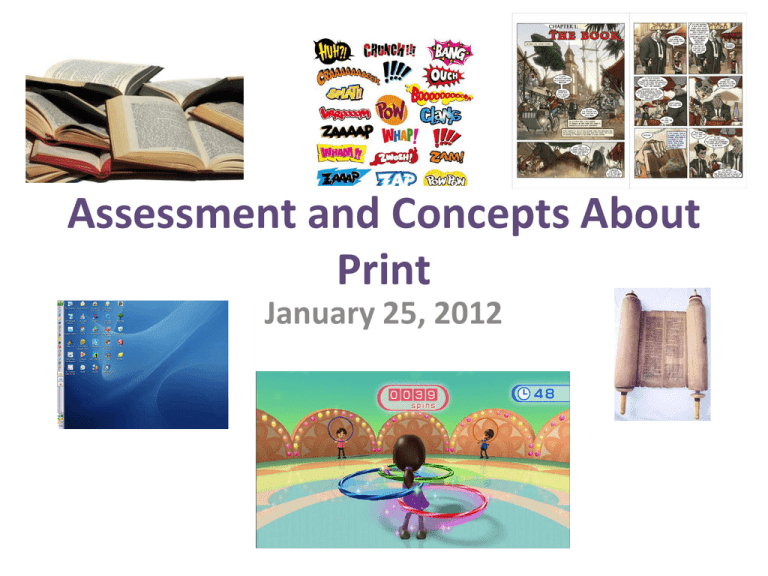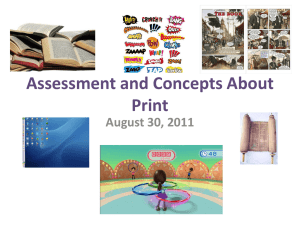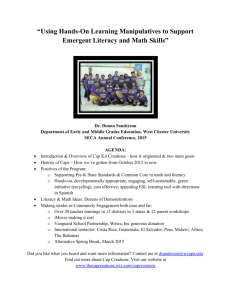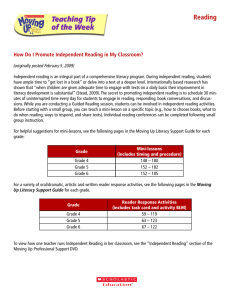Assessment and Concepts About Print - CI209-LiteracyII
advertisement

Assessment and Concepts About Print January 25, 2012 Announcements • Tutoring Kit questions or great finds? • Discuss Assessment Cycle and Constructive Assessment • Define Concepts About Print • Identify methods for Assessing Concepts About Print (CAP) • Discuss the nature of technology in classrooms today • Discuss Web Literacy Book Walk A strategy to familiarize a reader with new reading material. This process helps with comprehension of the text and to formatively assess a students understanding about different types of texts and how they are used. • In groups of 4, discuss the “Textbook Walk questions. • We will discuss as a whole group. Big Ideas: Teacher Discourse • • • • • Being a “constructive evaluator” Assessment as “social interaction” The “language of assessment” Trust, power and control Trajectory- “Where was I?” Where am I now?” “How did I get there?” • The Implications of teachers’ responses Building an Insider View: Social Imagination “The ability to read others” “…. The possibility of understanding our own and others’ experiences from that many more vantage points” “Valuing, exploring, and appreciating multiple perspectives in the classroom.” (Johnston, Knowing Literacy, 1997, Owacki & Goodman, Kidwatching, 2002) Assessment Assessment: What do you know about assessment? How is it used? What materials/tools do teachers use to assess students? What counts? • Ideas from Kidwatching – What is Kidwatching? – What can we learn from it? – How does it differ from other types of assessment you’ve experienced? Assessment Cycle National Reading Panel • NRP was formed in 1997 to research and assess effective literacy instructional practices • Research was conducted over a period of 2 years • In 2000, the NRP published a report outlining the findings What are we supposed to teach? NRP Findings Concluded that there are five key components to an effective reading instruction program: • Phonemic Awareness • Phonics • Fluency • Vocabulary • Comprehension Development of Common Core Standards Supported by: • Achieve • ACT/SAT • College Board 11 Readin g Language ELA CCSS Website http://www.corestandards.org/ ISBE http://isbe.net/common_core/default.htm Illinois Interactive Report Card (IIRC) http://iirc.niu.edu/ Speaking & Listening Writing What to assess? What might you want to know about your students? How can you find out? Use this to list the assessments that you have learned about and how you might choose to apply them to tutoring with your student. Consider what it is you want to know and the purpose of the assessment. What does this assessment designed to do? What information can you get from it? How does it fit in with other assessments? Why give this assessment? (what is the purpose; which of 6 language arts can you gather information about? ) What changes need to be made? (what are the pros/cons of this assessment?) What do you still need to know? Concepts About Print Understanding how texts and printed language work. • Shout Out – What do people need to know and be able to do in order to access printed texts? • Think About it: Insect Soup Concepts About Print • What are concepts about print? (From Marie Clay’s Observation Survey) – – – – – Print orientation (Directionality) Letter identification High frequency words Writing Spree Dictation • What tools do we have to help us assess a child’s understanding of concepts about print? Let’s Try It- CAP Harrison’s VoiceThread http://youtu.be/AAPB_g3ZAyo (Advertisements) http://youtu.be/yzIZ1415nuM (It’s Not Easy Being a Bunny) http://youtu.be/RuYzOby2_CY (Dalmations) Make a “checklist” of a few things you might expect to observe regarding print orientation. What do these children know about print and texts? Ideas for teaching CAP • • • • Class books Environmental Print Charts Shared Reading and Read-alouds (Use Big Books with the whole class) • Use available technology as well Other ideas from the reading or other classes that you may want to try? CAP and New Literacies What understandings of how texts work do you need for the following? • Technological Literacy • Visual Literacy • Media Literacy • Information Literacy How might you assess it? • Divide into groups of 4 • Share ideas from Digital Storytelling – Make connections – Ask questions • Discuss your Key Ideas from the reading and discuss how this might impact your work with children? Big Ideas Chart • So what does all of this mean for us? • What will this look like when we are working with our students? Assessment Chart • What assessments did we discuss today? Add them to your chart. Next Time Read Choice Words, Ch. 3, 4 & 5 Add a thought to the Big Ideas chart Think about you Tutoring Kit






